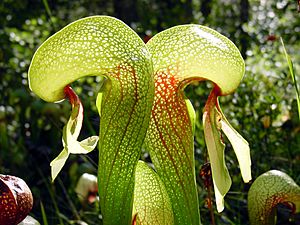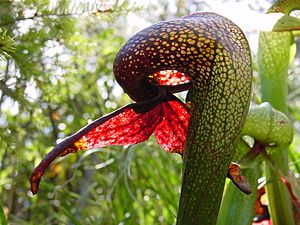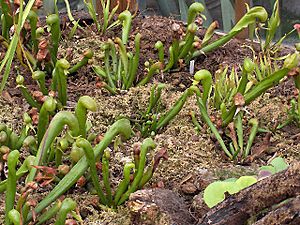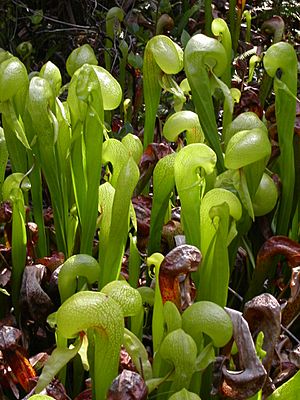Cobra lily facts for kids
Quick facts for kids Cobra lily |
|
|---|---|
 |
|
| Darlingtonia's translucent leaves confuse insects trying to escape | |
| Conservation status | |
| Scientific classification | |
| Genus: |
Darlingtonia (plant)
|
| Species: |
californica
|
 |
|
| Darlingtonia distribution | |
| Synonyms | |
|
|
The Darlingtonia californica is a special kind of carnivorous plant often called the California pitcher plant, cobra lily, or cobra plant. It's the only plant in its group, Darlingtonia, and it's part of the Sarraceniaceae family.
This amazing plant grows naturally in Northern California and Oregon. You can find it in wet, swampy areas and places where cold water flows, like bogs. It's considered uncommon because it's not found everywhere.
People call it the "cobra lily" because its long, tube-shaped leaves look a lot like a cobra ready to strike! It even has a forked leaf that looks like a snake's fangs or tongue. These leaves can be yellow, green, or even purplish.
A botanist named William D. Brackenridge first found this plant in 1841 near Mount Shasta. Later, in 1853, John Torrey officially described it. He named the plant's group, Darlingtonia, after another botanist, William Darlington.
In the UK, this plant is so special that it won an award called the Royal Horticultural Society's Award of Garden Merit.
Contents
How the Cobra Lily Lives
The cobra plant doesn't just live in poor, acidic soils. Many of them actually grow well in a different kind of soil called ultramafic soil, which is more basic. Like most carnivorous plants, the cobra lily gets extra nutrients, especially nitrogen, by eating insects. This helps it grow in places where the soil doesn't have much nitrogen.
Its Roots
Carnivorous plants often live in tough places, so their roots are very special, just like their leaves. The cobra lily's roots are quite delicate. Even though the air can get hot where it lives (over 25°C or 77°F), its roots can die if the temperature goes much above 10°C (50°F). This is unusual because most plants have roots that can handle similar temperatures to their leaves. Scientists are still trying to understand why this plant's roots are so sensitive to heat.
How It Traps Insects
The cobra lily is unique among American pitcher plants. It doesn't collect rainwater in its pitcher like some others. Instead, it controls the water level inside its trap by moving water from its roots.
For a long time, people thought this plant didn't make its own digestive juices. They believed it relied on tiny bacteria and other small living things to break down the insects it caught. But recent studies show that the Darlingtonia actually makes at least one special enzyme that helps digest its prey. The plant is very good at trapping insects; its pitchers are usually full of bugs and their remains!
The cobra lily uses a few clever tricks to catch insects:
- It has slippery surfaces and downward-pointing hairs inside its pitcher, which make it hard for insects to climb out.
- It hides the real exit hole by curling it underneath.
- It has many clear, see-through patches on its "hood" that look like false exits. Insects try to fly out through these clear spots, get tired, and fall deeper into the trap.
Another pitcher plant, the parrot pitcher plant (Sarracenia psittacina), uses a similar trick. The hooded pitcher plant (Sarracenia minor) also uses clear patches, but its exit hole isn't curled under like the cobra lily's.
Some people thought the cobra lily's forked "tongue" was for trapping insects. However, a study found that even if you remove the tongue, the plant still catches the same amount of prey. So, the tongue is probably not for trapping.
How It Gets Pollinated
One interesting mystery about the cobra lily is how its flowers get pollinated. Its flower has a very unusual and complex shape. This often means that a specific insect is needed to pollinate it. The flower is yellowish-purple and grows on a stalk. It has five green sepals (leaf-like parts) that are longer than its red-veined petals. Scientists thought it might be pollinated by a fly or a bee attracted to its smell, or maybe even a bug that flies at night.
A newer study suggests that a type of miner bee (Andrena nigrihirta) might be its main pollinator. These bees seem to help the plant's stigma (the part that receives pollen) get touched when they enter and leave the flower. The study also found that the Darlingtonia often doesn't get enough pollen in the wild. However, even if there aren't many male plants around, the cobra lily can still reproduce, which means it might be able to self-pollinate sometimes. It seems like both ways of pollination might happen, which helps the plant survive in the wild.
Growing Cobra Lilies
Growing Darlingtonia californica can be tricky because it needs very specific conditions. These plants like cool to warm daytime temperatures and cool or cold nights. Cobra lilies usually grow in bogs or near streams that have cold mountain water. They grow best when their roots are kept cooler than the rest of the plant.
If you want to grow them, it's best to copy these conditions. Water them with cold, purified water. On hot days, you can even put ice cubes made of purified water on the soil surface to keep the roots cool. They like sunny spots if the air is humid and warm. If the humidity is low, they prefer some shade. While they can get used to lower humidity, they grow best with good humidity.
Growing cobra lilies from seed is very slow, and young plants are hard to keep alive. So, it's usually better to grow them from the long stolons (runners) they produce in late winter and spring. When you see a tiny cobra plant forming at the end of a stolon (usually in mid to late spring), you can cut the stolon into pieces a few inches long, making sure each piece has some roots. Place these pieces on cool, moist, shredded long-fibered sphagnum moss in a humid spot with bright light. After many weeks, new cobra plants will start to grow from each section of the stolon.
Like many other carnivorous plants from cooler areas, cobra lilies need a cold winter rest period (called dormancy) to live a long time. During very cold winters, the plants might die back to their underground stems (rhizomes). In cooler winters, they might keep their leaves during this rest period. This dormancy lasts about 3 to 5 months, and the plant stops growing.
As spring arrives, mature plants might send up a single, nodding flower. A few weeks later, the plant will grow some large pitchers. It will keep making pitchers throughout the summer, but these will be smaller than the ones that grew in early spring.
Many people who love carnivorous plants have successfully grown cobra lilies. They've even found or developed three different color types: all green, all red, and red-green. Wild plants are usually all green in moderate light and turn red-green in very bright sunlight.
Images for kids
See also
 In Spanish: Darlingtonia californica para niños
In Spanish: Darlingtonia californica para niños











